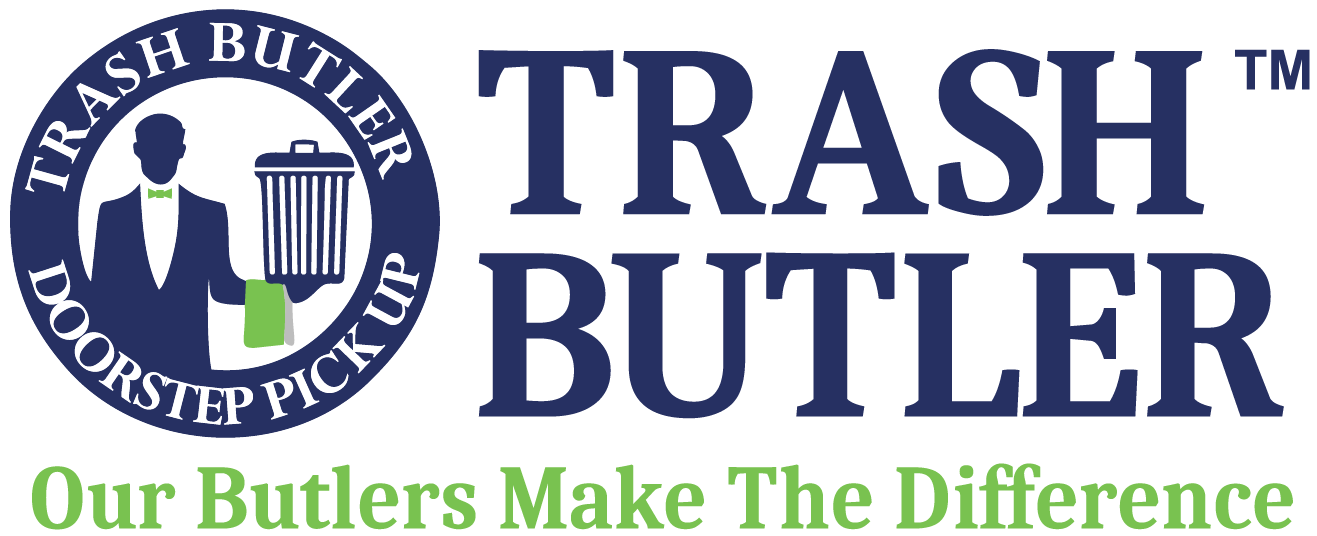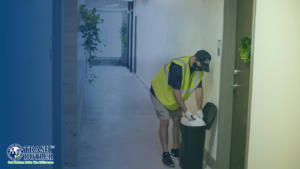Key Takeaways:
- Transforming waste management through education, incentives, and technology enhances environmental sustainability and resident satisfaction.
- Regular waste audits and strategic partnerships with professional services like Trash Butler™ optimize operational efficiencies and regulatory compliance.
- Key success metrics such as diversion rates, contamination levels, and resident participation drive continuous improvement in multifamily waste management programs.
Effective waste management is a cornerstone of maintaining a healthy, efficient, and environmentally responsible multifamily community. With numerous households contributing to a shared waste stream, it is crucial to implement robust strategies that ensure proper disposal, recycling, and waste reduction.
In multifamily settings, challenges such as diverse waste habits, space constraints, and varying levels of resident engagement can complicate waste management efforts.
This guide offers practical tips and best practices for multifamily property managers, residents, and maintenance staff. By following these recommendations, communities can improve their waste management systems, reduce environmental impact, and promote a cleaner, more sustainable living environment.
What Is Multifamily Community Waste Management?
Multifamily community waste management is not just any area of environmental management, it’s a highly specialized field dedicated to handling and reducing waste in apartment complexes and similar residential communities. This process involves various activities designed to collect, sort, transport, recycle, or dispose of the waste produced by the residents of these communities, requiring a unique set of skills and knowledge.
Effective waste management in multifamily settings is crucial due to the density of residents and the unique challenges that arise from such living arrangements. Without a proper system, these communities can experience increased pollution, health hazards, and decreased quality of life.
The core components of multifamily community waste management include:
- Collection: This is the first step in waste management where waste is gathered from each point of generation, primarily in individual apartments or designated communal areas.
- Segregation: Effective segregation involves separating waste into categories such as organic, recyclable, and residual waste. This step is vital as it directly impacts recycling and disposal.
- Transportation: Once collected and sorted, waste must be efficiently transported to facilities where it can be processed, recycled, or disposed of.
- Recycling: This involves processing recyclable materials (such as plastics, glass, and paper) into new products to prevent waste of potentially useful materials and reduce the consumption of fresh raw materials.
- Disposal: The final stage of the waste management process involves the safe disposal of non-recyclable materials.
The Benefits Of Sustainable Multifamily Community Waste Management
Implementing a sustainable waste management system in multifamily communities not only addresses environmental concerns but also enhances the living experience for residents and boosts the property’s value. Here are several key benefits:
Environmental Impact Reduction
Sustainable waste management significantly reduces landfill waste, lowers greenhouse gas emissions, and conserves natural resources. By focusing on recycling and composting, communities can decrease their ecological footprint, contributing positively to environmental conservation.
Cost Efficiency
Implementing recycling and composting programs diverts materials from expensive landfills to more cost-effective recycling and composting facilities, thus reducing waste disposal costs and promoting sustainable waste management practices. These practices encourage the efficient utilization of resources like energy and water, resulting in long-term cost savings through decreased utility bills and operational expenses.
Enhanced Community Appeal
Communities that prioritize sustainability often attract environmentally conscious residents, which can lead to a more engaged and satisfied resident base. This can be a significant competitive advantage in the densely packed market of multifamily units.
Regulatory Compliance
Many regions are now implementing stricter regulations on waste management. Sustainable practices ensure that your community complies with such regulations, avoiding potential fines and legal complications.
Improved Quality of Life and Resident Satisfaction
Providing a clean and well-managed waste disposal system improves the overall aesthetics and hygiene of the community. This, in turn, enhances the quality of life for residents, making the community a more attractive place to live. High resident satisfaction reduces turnover rates and fosters a positive community environment.
How To Implement A Successful Multifamily Community Waste Management Program
Effective waste management is a critical component of successful multifamily community operations. This section outlines a strategic approach to establishing a program that optimizes waste collection, fosters resident participation, and achieves cost reductions and environmental sustainability.
Comprehensive Needs Assessment
- Waste Stream Analysis: Conduct a thorough evaluation of your community’s waste types and volume. This data will inform the selection of appropriate bin sizes and optimal collection frequencies.
- Resident Survey: Gauge resident awareness and existing waste disposal habits through a targeted survey. The feedback gathered will guide program development and address residents’ specific concerns.
Design a User-Centric System
- Strategic Bin Placement: To ensure resident convenience, strategically place labeled bins for trash, recycling, and organics (if applicable) in accessible locations throughout the community.
- Standardized Signage: Utilize standardized signage with clear and concise visuals to identify acceptable waste types for each designated bin. Consider multilingual signage for diverse resident populations.
- Resident Education Campaign: Implement a comprehensive resident education campaign. This may include informational meetings, flyers, brochure distribution, and the development of online resources to educate residents on proper waste sorting and disposal practices.
Optimize Collection Frequency
- Waste Volume Monitoring: Continuously monitor waste bin usage to determine if collection frequency requires adjustment. Consider potential seasonal variations in waste generation to ensure efficient service.
- Partnership with Reliable Haulers: Collaborating with a professional waste management service like Trash Butler™ can streamline your community’s operations. Our doorstep valet trash service offers residents convenience and ensures regular and efficient waste collection.
Foster Resident Accountability
- Participation Incentives: Consider implementing incentive programs or gamification elements to encourage resident engagement in recycling and responsible waste disposal practices.
- Convenience Measures: Provide small, dedicated recycling bins for kitchens and bathrooms to make recycling effortless for residents.
- Clear Communication and Enforcement: Effectively communicate and enforce community waste disposal guidelines to minimize contamination and maintain program effectiveness.
Monitor, Evaluate, and Adapt
- Monitor the effectiveness of your waste management program regularly: Evaluate the sustainability impacts, the level of resident participation, and any challenges faced. Use this data to make informed adjustments to the program, ensuring it remains efficient and effective.
Integration of Technology (Optional)
- Smart Bin Sensor Technology: Explore the potential benefits of utilizing smart bin sensors that monitor bin fullness and optimize collection schedules, leading to improved efficiency
- Resident Mobile Applications: Introduce or utilize existing waste disposal mobile applications to provide residents with a convenient platform to access information, report waste disposal issues, and request additional services.
By implementing this strategic approach and continuously monitoring and adjusting the program as needed, you can establish a multifamily community waste management program that is both high-performing and environmentally responsible. Remember, the success of such a program relies on a collaborative effort between residents, property management, and waste disposal partners.
Common Challenges In Multifamily Community Waste Management And How To Overcome Them
Multifamily community waste management presents unique challenges that require strategic planning and innovative solutions. Here are some of the most common hurdles communities face, along with strategies to effectively overcome them:
Limited Space for Waste Facilities
Multifamily properties often have restricted areas available for waste collection and recycling facilities. This limitation can lead to inefficient waste management practices.
- Solution: Optimize space by using multi-stream waste containers that separate recyclables, organics, and waste within a compact unit. Rest assured, our professional waste management service, Trash Butler™, with its extensive experience and expertise, will design a custom plan that fits the available space and maximizes waste diversion, ensuring the best possible solution for your multifamily properties.
High Volume of Waste
The density of residents in multifamily communities naturally leads to a high volume of waste, which can overwhelm traditional waste management systems.
- Solution: Implement a structured waste pickup schedule and provide sufficient containers to handle the volume. Trash Butler’s doorstep valet trash service ensures regular and efficient waste collection, reducing overflow and maintaining a clean environment for residents.
Diverse Recycling Needs
Residents in multifamily communities come from various backgrounds and may have different awareness levels and habits regarding recycling.
- Solution: Conduct regular educational campaigns about the importance of recycling and the correct ways to do it. Clearly label recycling bins and provide guidelines on what materials can be recycled. Trash Butler™ can assist in these educational initiatives, helping to increase recycling rates and reduce contamination.
Inadequate Resident Participation
Getting residents to comply with waste management policies can be challenging. Without participation, the effectiveness of any waste strategy is significantly reduced.
- Solution: Foster a community culture that prioritizes sustainability. Host workshops and provide incentives for residents to participate actively in the community’s waste management programs. Regular feedback and updates on the environmental impact of their efforts can motivate residents to participate more actively.
Regulatory Compliance
Waste management regulations can vary greatly from one region to another, and staying compliant can be a complex process for multifamily communities.
- Solution: Work with waste management experts who are familiar with local and federal regulations. Trash Butler™ ensures that your waste management practices comply with all laws, helping avoid penalties and legal issues while promoting sustainability.
Technology Solutions For Streamlining Multifamily Community Waste Management
Technology is revolutionizing multifamily waste management. Here are key tools:
- Smart Bin Sensors: Optimize collection schedules, reducing costs and environmental impact.
- Resident Mobile Apps: Provide instant access to waste disposal information and reporting tools, boosting resident engagement.
- Data Analytics Platforms: Offer insights to optimize bin placement, collection frequencies, and waste reduction efforts.
- Gamification Apps: Motivate residents through fun, competitive waste sorting and recycling practices.
Benefits:
- Cost savings through optimized collection.
- Increased efficiency with real-time data insights.
- Improved resident engagement through mobile apps and gamification.
- Data-driven sustainability for informed decision-making.
Considerations:
- Cost-effectiveness.
- Resident technology adoption.
- Data security and privacy.
By strategically integrating these solutions, communities can create a streamlined, data-driven, and sustainable waste management program.
Measuring Success: Metrics For Evaluating Multifamily Community Waste Management Programs
So you’ve implemented a multifamily waste management program – fantastic! But how do you know it’s working? Here’s where metrics come in. These measurable indicators help you assess program effectiveness, identify areas for improvement, and demonstrate success to residents and stakeholders.
Key Metrics to Track:
- Recycling Rate: This measures the percentage of waste diverted from landfills through recycling programs. Aim for a continuously increasing rate.
- Diversion Rate: This broader metric includes recycling and composting (if applicable), providing a more comprehensive picture of waste diverted from landfills.
- Waste Reduction: Track the total volume of waste disposed of over time. A decrease indicates residents are generating less waste overall.
- Contamination Rate: Measure the percentage of non-recyclables found in recycling bins. A low contamination rate shows effective resident education and sorting practices.
- Resident Satisfaction: Conduct surveys or gauge feedback through communication channels to understand resident satisfaction with the program’s accessibility, convenience, and effectiveness.
- Waste Management Costs: Monitor waste disposal fees and collection frequency adjustments to track program cost-effectiveness.
Additional Considerations:
- Track data over time: Monitor trends in key metrics to identify areas of improvement and program effectiveness over time.
- Benchmark against industry standards: Compare your metrics to industry averages or those of similar communities to understand your relative performance.
- Resident feedback: Surveys and open communication channels provide valuable insights into resident behavior and program satisfaction.
- Regular Reporting: Develop a reporting schedule (e.g., monthly, or quarterly) to analyze data and communicate progress to residents and stakeholders.
Final Thoughts
Effective multifamily community waste management is essential for maintaining a clean and sustainable environment, enhancing the quality of life for residents, and ensuring compliance with regulations.
Apartment communities have the power to significantly reduce their environmental footprint. By implementing thoughtful waste reduction strategies, structured recycling programs, and efficient trash disposal services, you can make a real difference in the environment we all share.
At Trash Butler™, our commitment to excellence in serving multifamily apartment communities is unwavering. Our doorstep valet trash service and recycling solutions are designed to accommodate multi-family settings’ unique needs and preferences, making waste management effortless and convenient.
By choosing Trash Butler™, communities gain a partner who prides itself on sustainability and impeccable service, as embodied by our dedicated butlers.
Additional Read:
- What You Can Expect When Adding Valet Trash At Your Apartment Complex
- National Green Building Standard: What Property Managers Should Know
- The Benefits Of Implementing A Valet Recycling Program In Your Community
Frequently Asked Questions
What are the benefits of composting in multifamily communities?
Composting in multifamily communities helps reduce waste, lowers garbage disposal costs, and significantly decreases community-wide carbon footprints. This organic process converts food scraps and other biodegradable materials into a valuable resource that can improve soil health and support local greening projects or residents’ gardens.
How can property managers encourage recycling in multifamily communities?
Property managers can encourage recycling by providing clear, concise recycling instructions, implementing convenient recycling stations, and regularly communicating the benefits and goals of recycling. Organizing educational workshops or events can also enhance engagement and participation rates.
Who should be responsible for overseeing the multifamily waste management program?
Ideally, a designated sustainability officer or property manager should oversee the multifamily waste management program. This individual would be responsible for planning, executing, and monitoring all aspects of the waste management strategy, including recycling and composting efforts.
What are the legal considerations for multifamily community waste management?
Legal considerations include adhering to local, state, and federal waste disposal regulations. Property managers must ensure that waste handling and disposal procedures comply with these laws to avoid fines and legal penalties. Additionally, they should stay informed about changes in legislation that can impact waste management practices.
How can multifamily communities prevent illegal dumping and littering?
To prevent illegal dumping and littering, multifamily communities can install visible signage about the penalties for such actions, increase lighting around disposal areas, and provide sufficient trash receptacles throughout the property. Regular patrols by maintenance staff can also deter these activities.
How can multifamily communities address cultural or language barriers in waste management education?
Multifamily communities can address these barriers by providing multilingual waste disposal guidelines and educational materials. Hosting inclusive events that cater to various cultural practices and hiring bilingual staff can also improve communication and ensure that all residents understand and participate in the waste management program.
What are the most common recyclable materials in a multifamily setting?
The most common recyclable materials in multifamily settings include paper, cardboard, glass, plastic containers, and metals like aluminum and steel cans. Ensuring these materials are properly sorted can significantly increase the efficiency of recycling programs.
What’s the best way to set up a recycling program in a multifamily community?
The best way to set up a recycling program involves a few key steps: performing a waste audit, engaging residents through education, setting up clearly labeled recycling bins in accessible areas, and establishing a consistent pick-up schedule. Collaboration with a professional waste management service can also enhance program effectiveness.
What are some cost-saving strategies for multifamily waste management?
Cost-saving strategies include reducing overall waste production, negotiating better rates with waste management services, implementing recycling programs to lessen the volume of waste needing disposal, and considering investments in compaction devices to reduce waste collection frequency.
How can we stay updated on new regulations or best practices in multifamily waste management?
Staying updated can be achieved by subscribing to newsletters from environmental agencies, joining professional organizations focused on sustainability, attending industry conferences, and regularly reviewing updates from local government bodies. Networking with other property managers can also provide insights and share effective practices.





